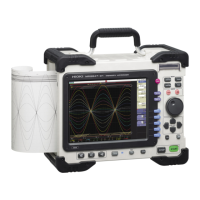10.2 Settings for Numerical Value Calculation
177
Chapter 10 Numerical Calculation Functions
10
(2)
Select the channel for calculations.
Move the cursor to the item for the calculation target, and
select the channel.
(A logic channel can also be selected for Time to Level, Pulse Width, Duty
Cycle, and Pulse Count.)
(3)
Set parameters.
Settings may not be necessary for some calculation types
When calculating time differences and phase contrast,
makes settings for A and B channels.
Move the cursor to the parameter items, and make appropri-
ate parameter settings.
See: "Parameter table" ( p.178)
See: "8.1.3 Alphanumeric Input" ( p.121)
(4)
Set the statistical calculation.
Move the cursor to the [Stat] column.
(5)
When time difference calculation or phase contrast cal-
culation has been selected, set Ch (channel) and param-
eters for A and B.
4
Execute the calculations. (when judging calculations (
p.180))
Applying Calculations to Existing Data
Select [Exec].
When calculating automatically after measurement
Press the START key to start measurement.
First Calculate at the first condition of the measurement data.
Average Acquire the average value of the calculation result in the
measurement data.
Max Acquire the maximum value from the calculation result in
the measurement data.
Min Acquire the minimum value from the calculation result in
the measurement data.
When printing or saving calculation re-
sults during measurement
Settings must be made before the mea-
surement.
See: "10.4 Saving Numerical Calculation
Results" (
p.183)
"10.5 Printing Numerical Calculation
Results" (
p.184)
When printing or saving existing data
Use PRINT key or SAVE key.
See: "5.2.3 Saving Data Selectively (SAVE
Key)" (
p.74)
"6.3 Manual Printing With PRINT
key (Selective Printing)" (
p.93)
To copy a calculation setting to another calculation number
Use the [Num Calc] sheet.
See: "8.9 Copying settings to other channels (calculation No.) (Copy function)" ( p.139)

